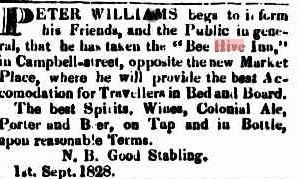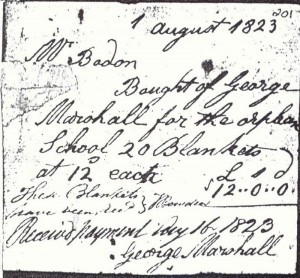Campbell Street prior to and during George Marshall’s Occupancy.
I have been working to establish the early history of the north side of Campbell Street between George and Pitt Streets opposite the contemporary hay and cattle market, particularly the dates from which Marshall occupied the Campbell Street frontage, when he had the legal capacity to dispose of two blocks carved out of that frontage (Lots 9 and 10), and eventually gained Title to the balance (Lot 11).
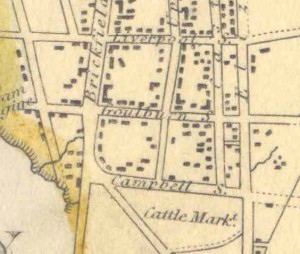
Brickfield Hill (George St) and Campbell St in 1831. The Marshall property is above the “Ca” in Campbell Street.
George Marshall (ca 1783 – 1828) was my great great great grandfather, transported on the “INDIAN” in 1810 for stealing cloth, most likely from his employer in Somerset. As a ‘clothier’ he was assigned to Simeon Lord, receiving a Ticket of Leave in 1816, Conditional Pardon in 1818, and an Absolute Pardon in 1827.
Marshall said in 1824 that he had “..for some years carried on the manufactory on the Brickfield Hill.” [1] He was certainly there in 1822[2], and there is some documentation supporting the view that he was there with his family before 1822, despite working for Simeon Lord. There was no impediment to his setting up a residence wherever he chose, possibly from the time he married in 1815, and certainly from the time of receiving his Ticket of Leave in 1816, so long as it was within the Sydney district. In and around 1820, there had been some settlement from the town along Brickfields, later known as George Street and the related area, Campbell Street. (Although he had used Campbell St in his 1825 petition for a Grant of land, Marshall was still giving his address as “Brickfield Hill” as late as October 1826.[3] )
The area surrounding what became Campbell Street, one mile from the town, was mostly undeveloped, being the site of Sydney’s brickfields and very swampy. Obed West described the area between built up Sydney and ‘George St West’, which was ‘…quite out of town…’, as an area of the ‘…the ti-tree shrub, the vacant blocks, the mud and wattle cottages and thatched roofs…..the few shopkeepers and artisans…’[4] The progressive settlement attracted first the hay and cattle markets, opened in 1818, and the factories, market gardens, and later the corn and food markets. In 1819 Marshall had “1 horned cattle and 6 hogs”.[5] Two years later he had a “Garden or orchard – ¼ acre, 5 horned cattle and 2 hogs.”[6] He may or may not have held the quarter acre at Campbell Street, but it would be useful if it can be shown that these animals were kept at Campbell Street. If not, where? In any case, the George to Pitt site, which he held later, was much bigger than a quarter acre.
In 1822 – the 1822 District Constables’ Notebook – there appeared to be resident in the street only four families, all former convicts, but now free, as well as their assigned servants,. Apart from the Marshalls and their two “currency” children (Mary Ann b. 1815, and Charles b.1817), and their assigned convicts, there were the family of John Holmes (‘H M S Gorgon’ 1791) and his wife Eleanor Stores (‘Nile’ 1802) and their 20 yr old son Edward; John Parks (‘Barwell’ 1798), his wife Margaret Suthers (‘Experiment’ 1804) and their nine children, all born in the Colony, and Thomas Bates (‘Hillsborough’ 1799) his wife Hannah Field and their two children.[7] Other families were listed on the Brickfields and the Benevolent Asylum beyond the hay market. The 1822 Convict Muster lists Marshall, living with his wife and two children in Sydney, as a ‘cloth manufacturer’. He sold blankets to the male Orphan School on occasions during 1823. In early 1822, convict servants John Blackburn (“John Barry”), Robert Hudson (“Prince of Orange”), and Christopher Gilligan (“Daphne”) were assigned to “George Marshall, Campbell Street.”[8] At least twelve convicts were assigned from time to time to Marshall at “Campbell St” or “Brickfields” between 1822 and 1826, and more to his widow in later years.
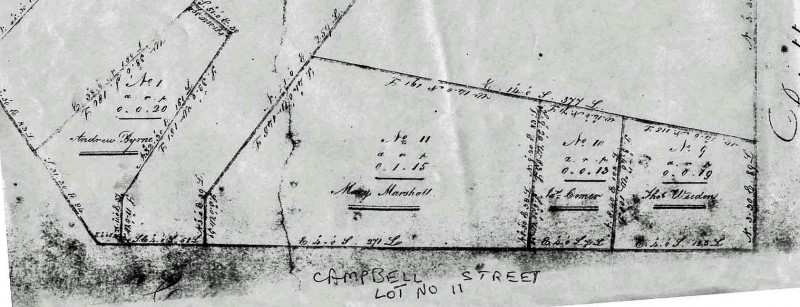
Lot 11 Campbell St assigned to Mary Marshall, widowed in 1828. Blocks 9 and 10 had been sold earlier by George Marshall.
In September 1824, Marshall told the Governor, when seeking land at Botany, that he was
“…by trade a clothier and blanket maker, and has for some years carried on this manufactory at Brickfield Hill….” [9]
Some time before the end of Sir Thomas Brisbane’s term as Governor in November 1825, he
“…signed his name to a plan of the house intended to be built (on what is Lot 11) by G Marshall, which was afterwards erected by his widow—cost £500.””[10]
Consequently the Government, at the highest level, acknowledged in the first half of the decade, occupancy, and perhaps ownership, of the Campbell St site.
On 28th September 1827 George Marshall, giving as his address “Resident on the said Dwelling near unto the old Toll Gate.” wrote to the Colonial Secretary in the following terms:
“Having erected considerable Premises, laying being and situate in Campbell Street, Sydney at a considerable expense upon the same and wishing to obtain a grant to effect my Security for my Exerted Industry agreeable to Government and General Orders as a particular favour from your Honoured Executive Authority be pleased to give the necessary Orders to the architect for valuing the same.” [11]
His claim to have built on the site was confirmed in Ambrose Hallen’s 1829 Survey. A notation on the Survey of the Marshall land reads :
” Sir Thos Brisbane signed his name to a plan of the House to be built by G Marshall which was afterwards erected by his widow – cost L500.
A further notation above the two houses, on which he had written Pds 500 and 600 respectively, reads:
“ “The original Geo? Marshall. Mary the widow lives on the premises has built to the amount of about £1100″ The amounts £600 and £500 are written across the two main buildings.”
The remaining two blocks to the right of the picture above were sold off by Marshall on the Pitt St end. “James Comers purchased from Marshall” and “Thos. Weedon purchased from Marshall” are annotated on these blocks. (Comers paid Marshall ninety pounds for his block.)
Consequently, a month after Marshall’s letter to the Colonial Secretary, on 27 August 1828, the Surveyor General reported that:
‘Governor Phillips (sic) gave it to his gardener Mitchell. There is no written document’; that “It was sold by public auction through the Provost Marshall. Purchased by George Marshall’; and that “A large brick house, two stories. It is the sign of the Bee Hive. Another house is also building”. [13]
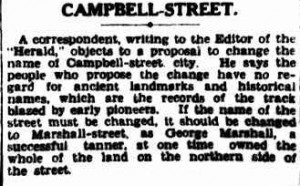
George Marshall, Campbell Street, Haymarket. SMH item of 15 March 1934. It is likely that the ‘correspondent’ was Louis Murray (1871-1938), employed in the Anthony Hordern Haymarket store, and great grandson of George Marshall.
The address in the early twenties was merely “Brickfield Hill” or the “Brickfields”. The bricks were hauled into Sydney by teams of eight to ten convicts, yoked to heavy wooden carts across the corner of Campbell and George Streets, and up the then steep Brickfield Hill (George Street). George Marshall’s granddaughter, Elizabeth Clare (Conyngham) told her own granddaughter in later years that she remembered seeing convicts in chains and bullock teams building George Street.[14] Brickfield Hill itself, before it was levelled by the convict chain gangs, was a quagmire in the rain, steep and dangerous, and over a million cubic feet of stones and earth were removed from it by the carters to give the gradual slope of today’s road.[15]
The excavations and resultant dust blown into the town from the south coming in at the end of a hot day, bringing, at that time, dense clouds of red dust across Campbell Street and the hay market into the Sydney town itself. The storm gave rise to the contemporary term “a brickfielder”, called nowadays a ‘southerly buster’.
I have seen it written that Campbell Street was named by Governor Darling in honour of Robert Campbell (1769-1846), the pioneer merchant, whose wharf and warehouses were at the other end of town. At the time of George’s residency, Campbell was a member of the Legislative Council. Named after Campbell it may have been, but Governor Darling could not have named it. The document assigning Christopher Gilligan to Marshall in July 1822 clearly refers to ‘Campbell St’[16]. And the District Constable referred to “Campbell Street in his 1822 Notebook census.[17] Darling did not arrive in the Colony until December 1825, so he could not have named Campbell Street. However it is more likely that the street is named after Lachlan Macquarie’s Colonial Secretary, John Thomas Campbell, (1770? – 1830) whom the Governor held in warm regard. Such was the view of one Edgar J Godfrey, a regular correspondent, particularly regarding street names and historical locations, to the Sydney Morning Herald. His letters making this claim were published on 9 July 1928 and 31 May 1934 respectively.
George Marshall’s woollen manufactory was a going concern at the time of his death, when his Executors stated the value of his estate to be “…not more than £2,500.” He had left land, housing, cattle and had sufficient financial resources to build an extra building on his site and open an Inn. His widow continued the work and proceeded to build the extra premises. This was described in his Will as
“….all my house &. premises with the grounds thereunto belonging situate in Campbell Street Sydney also the Grounds adjoining same upon which a dwelling house I intended to build the foundation of is begun also my factory belonging to said premises situate in the rear of the said building so commenced with all rents advantages benefits & emoluments that may be derived therefrom….”
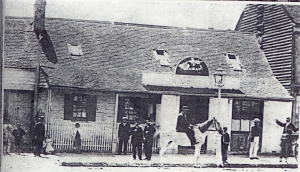
Packhorse Hotel, which was adjacent to the Marshall/Conyngham properties.
It will be seen that Marshall’s Will suggests that some rental was coming in from the property, though this is not defined. However, shortly after his death, the “Beehive Inn “ was functioning on the site. Marshall clearly had intended to operate the Inn himself (as daughter and son-in-law did in later years) since he had just received a Publican’s Licence. Given Marshall’s demise, it was presumably leased to one Peter Williams, who advertised in the Sydney Gazette in September 1828. Following Peter Williams, the initial Licensee, Christopher Flynn and James Greenfield appear to have been the proprietors between 1830 and 1835, at which time we have the first evidence that Marshall’s son-in-law Edward Conyngham terminated the leasing arrangements and took over the management of the Inn by himself and his wife, Mary Ann (Marshall) Conyngham.
It was not until the Commissioner of Claims process[18], undertaken in 1834/35 to formally establish Title over many NSW residents’ property holdings, to satisfy the NSW Supreme Court, that full legal entitlement to occupancy was established.[19] On 19 April 1834, the Executors of George Marshall’s Will wrote to the Commissioners that:
“The said land was in the lawful possession and occupancy of the said George Marshall deceased, more than twenty years ago….”
If this were so, occupancy and perhaps ownership would have dated from 1814, which is unlikely. Though one is led to ask, in this context, ‘where did the newlyweds live after their January 1815 marriage’? The list of supporting witnesses stated that four men, Samuel Hockley, Butcher, of George Street, Sydney; Thomas Dean, Fishmonger, of 40 Pitt Street South, Sydney; Robert Fennell, Fishmonger, of Bunnerong, Botany Bay; and ‘David Braithwaite, labourer, of Bunnerong, Botany Bay would:
“….prove that George Marshall bought the land herein claimed from one Mrs Mitchell, 18 years ago, and that the said Mrs Mitchell had possession thereof more than 20 years ago…..”
The papers do not show whether all these witnesses gave evidence, but Samuel Hockley (Royal Admiral’ 1792) did so. His statement to the Commissioners on 8 September 1834 did not go so far as to claim that Marshall had the land more than 20 years ago, He signed a statement, however, that he:
“…..knew George Marshall, deceased, the husband of Mary Marshall. Their premises were in the Marshall’s possession in 1823, and were so for many years before …..”
The Commissioners, in their final report dated 15 June 1835, at least provided, for all time, part of the solution. They stated that they:
“…. had ascertained from evidence brought before them that the Land claimed was in possession of George Marshall in 1823 and for many years before…..”
So, “many years before 1823” is well accepted and proven, but we want a more precise date! A key source is the Provost Marshall’s auction. Such sales were notified in the Sydney Gazette of the time. I have worked through some contemporary newspapers, without success.
George Marshall died on 29 June 1828, having sold the blocks 10 (earlier that year for £90 to James Comer[20]) and 9 (to Thomas Weedon.) Marshall’s son-in-law Edward Conyngham (1805-1868), my great great grandfather, who had emigrated from Ireland in 1829, being shipwrecked in the Atlantic on the way, had been functioning as a weaver and hatter, presumably from the “Mill” or factory located on the adjoining block eventually willed to his brother-in-law, Charles Marshall. Charles, described in a later document[21] as “Woollen manufacturer” had presumably exercised his rights over his land and operated the factory. So it is understandable that Edward and Mary Ann would have turned their full time attention to the Bee Hive Inn on “their” land – which they knew was to be willed to them after the death of Mary Ann’s mother.
The 1834 NSW Directory has ‘Edward Cunningham (sic), Weaver, Campbell Street, Sydney’ and ‘Marshall, Mrs, 3 Campbell Street, Sydney.’ In 1837 Charles gave 3 Campbell St as his address when applying (possibly on behalf of others – another story) for land.
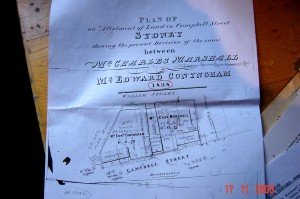
Block 11 was divided for the two Marshall children. Charles and Mary Ann, who had earlier married Edward Conyngham.
During this time, the family continued in Campbell Street, where, in 1838, soon after their mother’s death in July of that year, the 1300 square metre block was divided into two blocks, one willed to Charles Marshall and the other to his sister Mary Ann though registered in the name of her husband Edward Conyngham. In a list of Publicans for 1842 – 43, included was Edward Cunningham (sic), Bee Hive, 9 (sic) Campbell St.[22]
Though Conyngham and his wife moved later -1849 – to take over the Dublin Tavern on George St (on the site of the present Sir George Young Hotel), there is evidence, in a Brisbane newspaper report of a fire on the site, that Conyngham still owned the Campbell Street land as late as 1863[23].
As already stated above, when Brickfield Hill was levelled and the swampy area at Campbell St was filled in, the site was likely covered by about three meters of landfill, thus preserving much to tell us of life at the time. The commencement of the Meriton skyscraper puts paid to any dig on the site.
In the meantime, what of the Mitchells, the original occupants. How did they obtain and use the land?
Nathaniel MITCHELL was tried at Dorchester, Dorset on 3 August 1786 for stealing cheese and other goods with a value of 2 shillings. He was sentenced to transportation for 7 years and as a First Fleeter left England on the ‘Charlotte’ aged about 36 at that time (May 1787). He had no occupation recorded. In the Colony he apparently became Governor Phillip’s gardener. (See above.) Further evidence that he was a gardener very soon after arrival was the fact that on Saturday 30th August 1788 he “was sentenced to 50 lashes for making use of peas and beans which he was given to sow for Surgeon White.” The 1814 Census has him down as a gardener, as did the 1806 record. The 1800-02 Census listed him as an “Expired or Emancipated Convict”.
It was the Governor’s practice in the very early days of the Colony to allocate – but not to grant – land, small plots, to Officers, and with it some assigned servants, to encourage provision of food to a community on the edge of starvation. We know that Phillip, himself a farmer in England while on half pay retirement before this assignment, brought seed and animals on his own account. It is quite logical therefore that he set aside land for himself and employed convicts on it. He told Lord Sydney in October 1788 that he had “sixteen acres at a small farm on the public account.”[24] This was the area now covered by the Domain including the present Botanical Gardens. In July 1790, 3 gardeners and labourers (alas, unnamed) were employed by him.[25]
Phillip reported often that the convicts, or most of them, assigned for menial agricultural duties, were not at all effective or enthusiastic. In short, they would not work, nor had they any experience on the land. Allocating some land so some convicts worked for themselves had better results. The infamous George Barrington wrote that “….a small number of convicts, working on their own accounts, effected more good than the whole body did while labouring for Government…”[26] It is not entirely impossible that Mitchell’s loyal service, if it was so, led the Governor to allocate some land to him in the Brickfields location. The land from Sydney to the Brickfield Hill area, including what became Campbell Street, was declared by Phillip to be held for the town and therefore not to be the subject of grants. However there were small farms in the area. When establishing nightwatch arrangements he included “…the detached parties on the different farms in the (the brick kilns) district.”[27] By 1792, the Surveyor General noted that there was in the Colony “…100 acres (of) garden ground belonging to different people including the convicts’ gardens.”[28] In the same year Governor Phillip “prepared a ‘return of Male Convicts, with their respective employments, on 23 July 1790.”. This included ‘3 gardeners and labourers employed by the Governor.’
Mitchell married Elizabeth (aka Isabella) LEICESTER in St Philip’s Church on 16 August 1790, less than six weeks after she landed at Sydney Cove. Elizabeth, age given as 36, had been sentenced to seven years transportation at the 9 January 1788 in the Old Bailey for the theft of a bundle of clothing which included sixteen caps and eight handkerchiefs, was embarked on the ‘Lady Juliana’ transport, Both signed the register with a mark X.
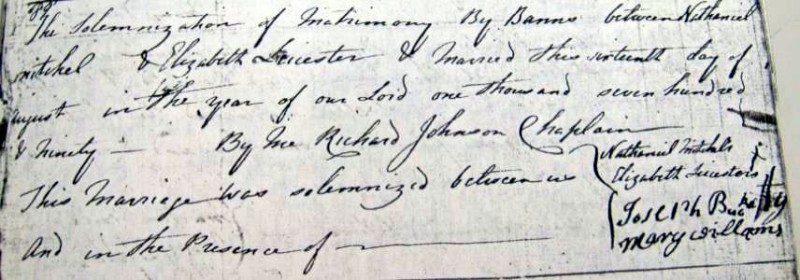
1790 Certificate of Marriage in St Philip’s Church, Sydney of Nathaniel Mitchell (1746-1820) and Elizabeth Leicester (1753-1820).
A record of their residence at the “Brickfields” in 1810 is found in the Sydney Gazette, reporting a robbery on 1 October 1810 at the “..habitation of Isabella Mitchell, an elderly woman in the Brickfields..binding down a man who slept in the house…” Interestingly Mrs Mitchell offered a reward of twenty pounds for information“.[29] The report of the Court case months later referred to the robbery …in the house of Nathaniel Mitchell in the Brickfields…”[30] A further robbery in 1819 does not state his place of residence, referring only to
“…its ancient owner, Nathaniel Mitchell, who exceeds 70 years of age, and has an equally ancient wife to support by the calling of a fisherman….. It is peculiarly a case of suffering, as it involves two poor people who have enumerated one hundred and forty winters betwixt them in a distress which by their willing industry they had tried to guard against…”[31].
Elizabeth died on 20 November 1820, age given as 67. The Sydney Gazette reported her death on the 25th, commenting that:
“The deceased had been an inhabitant of this colony for 30 years, having arrived here in the Lady Juliana, in June 1790, and although reduced to the lowest ebb of poverty, the poor old woman died respected.”
Her husband survived the loss of his wife by only a few weeks, dying on 20 December, 1820, age given as 74.[32]
This begs the question as to why it was said in the list of 1835 witnesses above that George Marshall bought the land from Mrs Mitchell at the Provost Marshall’s auction. On first glance, one would have assumed it was because she was the widow. However, she died before her husband!
The papers of the Provost Marshall may provide a clue. However enquiries at the NSW Archives have been fruitless.
Next steps?
[NOTE: A shorter version of this article was published in the March 2010 edition of ‘Descent’, the Journal of the Society of Australian Genealogists.]
[For some additional writings on Campbell Street history, (District Constable’s Notebook 1822; Old Sydney. Haymarket in 1858; From the Hordernian Monthly January 1938 (Australia’s 150th Anniversary Number); The Old Haymarket. – . From the Hordernian Monthly May 1938), click here.]
[1] SRNSW Fiche 3179 Page 230.
[2] District Constable’s Notebook. SR REEL 1254 Book 5. 1822…at the earliest mid 1822.
[3] SRNSW Reel 1156 31 October 1826.
[4] “The Memoirs of Obed West – A Portrait of Early Sydney” Edited by Edward West Marriott.
[5] Muster taken 6.11.1819…Reel 1256 4/1229
[6] Muster taken 1821 Reel 1256 4/1230.
[7] District Constable’s Notebook. SR REEL 1254 Book 5. 1822…at the earliest mid 1822.
[8] Fiche 3291 Item 4/4570D Pages 101, 116.
[9] SRNSW Reel 1075 Item 4/1838 Page 595.
[10] SRNSW Reel 2628. Hallen Survey Book 347 Ca. 1830 .
[11] SRNSW Reel 1203 Item 2/1786 Memorial 355. In register 27/9270 of 29 Sep 1827.
[12] Hallen Survey Field Book 347 Reel AO2628. Ambrose Hallen was the Govt Architect. JRAHS Vol 1 1901 Page 63.
[13] Surveyor General in 1828 , found in SRNSW Reel 1075 Item 4/1838 Page 595 of Commissioner of Claims Case 355 in 1835.
[14] 1984 conversation Jean (Murray) Hughes with Margaret (Cooke) Wilkinson.
[15] “Historic Sydney, as seen by early artists” by Susanna de Vries-Evans.
[16] Fiches 3290 and 3291 SRNSW
[17] District Constable’s Notebook 1822 Campbell St SRNSW Reel 1254
[18] SRNSW Reel 1203 Item 2/1786 Memorial 355.
[19] This process, on the claim of widow Mary Marshall and the two children related only to Lot 11, as Lot 9 and 10 were earlier promised, leased or sold to Thomas Weedon and James Comer respectively.
[20] ColSec Rec’d in 30/5409 – 20th July 1830 (NSW Archives Reel 1112)
[21] Lands Dept Book 7 (59a) Number 915 of 6 December 1844.
[22] Sydney Morning Herald 5.7.1842
[23] Brisbane Courier, 6 November 1863.
[24] HRNSW Vol l. Phillip’s letter to Lord Sydney 30 October 1788.
[25] HRNSW Vol 1 Part ll
[26] George Barrington. “History of New South Wales.” 1802
[27] HRA Vol 1 Series 1. Regulations promulgated by Judge Advocate David Collins.
[28] HRA Vol 1 Series 1.
[29] Sydney Gazette of 6 October 1810.
[30] Sydney Gazette of 16 February 1811.
[31] Sydney Gazette 6 February 1819
[32] “The Second Fleet. Britain’s Grim Convict Armada of 1790.” Michael Flynn
